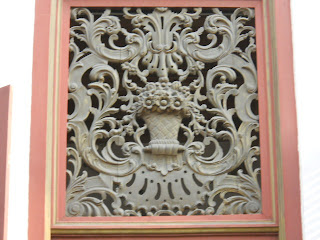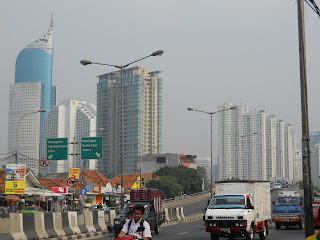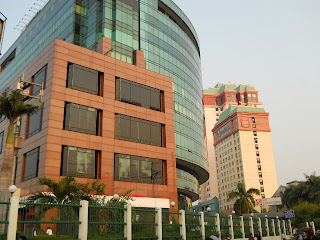 Gedung Arsip Nasional (National Archives Building) off Jalan Gajah Mada near Hotel Grand Paragon.
Gedung Arsip Nasional (National Archives Building) off Jalan Gajah Mada near Hotel Grand Paragon.The Dutch business community has helped in the restoration of an old Dutch East India Company's building which is a very valuable heritage site thus generating great interest among the general public as well as educationist.
Indonesia has little in the way of legislation for the protection of built heritage and as a result many privately-owned heritage buildings have been lost.
Some government-owned structures, such as the National Archives building, have so far been spared demolition but need private funding sources to enable restoration efforts to proceed.
This is the former home of VOC Governor General Reinier de Klerk of the Dutch East India Company in 1777.
The Dutch East India Company (Dutch: Vereenigde Oost-Indische Compagnie, VOC, "United East India Company") was established in 1602, when the States-General of the Netherlands granted it a 21-year monopoly to carry out colonial activities in Asia.
The Dutch nearest competitor is the British East India Company.
It is all about the rich spice trade especially pepper which has been the wealth of Indonesian archipelago and Banten in western tip of Java Island has been the main port.
In March 1599, a fleet of eight ships under Jacob van Neck was the first Dutch fleet to reach the 'Spice Islands’ of Maluku.
From 1720 on, the market for sugar from Indonesia declined as the competition from cheap sugar from Brazil increased.
European markets became saturated. Dozens of Chinese sugar traders went bankrupt which led to massive unemployment, which in turn led to gangs of unemployed coolies.
The Dutch government in Batavia did not adequately respond to these problems.
In 1740, rumors of deportation of the gangs from the Batavia area led to widespread rioting.
The Dutch military searched houses of Chinese in Batavia searching for weapons. When a house accidentally burnt down, military and impoverished citizens started slaughtering and pillaging the Chinese community.
This massacre of the Chinese was deemed sufficiently serious for the board of the VOC to start an official investigation into the Government of the Dutch East Indies for the first time in its history.
Olden days Dutch seal.
Discussion and conference hall.
Olden days sofa possibly made from teak or mahogany timber wood.
Round dining table with chairs having rounded edges carvings.
Document and gold deposit vault.
Tengku Muhammad Timbang standing beside his long sword-'keris'.
Teukoe Panglima Muhammad Timbang,originated from the 'Shahbandar'elite group from Acheh Province in North Sumatra. During ancient Malay states, the official who supervised merchants, controlled the port, and collected customs duties are known as Shahbandar.
On December 1872 at Tanjung Pinang,Tengku Muhammad Timbang was part of the Acheh Delegates that met the Riau Resident Governor,D.W.Schiff for a meeting.
In mid-Februaray 1873,the Dutch Consul(Konsul Belanda) in Singapura(Singapore)informed the Dutch East India Company(Hindia Belanda)headquarters in Batavia(old name for Jakarta) that the Shahbandar Delegates were on the way back to Acheh and approaching Singapore having contacted the American and Italian Consulate and inviting them to attack the Dutch.
The Italian Consul has discussed on the possiblity of sending Italain warships to protect Acheh from the Dutch attack.

Antique chest with a huge padlock.
The Governor's office with rosewood bookshelves wall cabinet.

Old mariners navigational compass.
Dutch Colonial fighters metal helmet similar to the Norman Crusade Helmet.
Olden days vintage antique piano in ebony wood furnishing.
The stool has a fixed swivel.
Bell inside the garden.

Wood Carvings at door entrance.
Wooden carvings near staircase.
Reiner de Klerk’s residence was constructed as a compound of five buildings.
The main building is a stately two-storey, brick structure with a high pitched roof and features a grand entrance hall and a beautifully decorated light vent above the main doors.
The other buildings in the complex are smaller but are similar in style and were built as administrative offices and to house servants.
 |
Cupboard/Armoires
Over its history the complex has changed hands a number of times.
After the death of Reiner de Klerk the buildings were sold and later became an orphanage.
The complex was subsequently abandoned and was left to deteriorate until the Dutch colonial Government converted it for use by the Mining Department.
In 1925 the main building was renovated and became the Landsarchief (national archive).
When the Indonesian Government took over the building upon Independence in 1945, it continued to function as an archive and has since been known as ‘Gedung Arsip Nasional Republic Indonesia’ (the National Archive Building of the Republic of Indonesia).
The Indonesian Government expanded the compound with the addition of a two-storey u-shaped building, joined to the rear auxiliary building.
The building’s function continued until the mid nineteen-eighties when the archives were relocated to a more modern building.
The complex then became vacant and steadily deteriorated until restoration work began in 1997.
Prior to the conservation project the building was suffering from weathering and neglect.
Because much of the site is below the surrounding ground-level, the buildings had been badly damaged by flooding over the years.
There was no natural surface drainage and drainage pumps were broken.
Rising dampness had damaged the walls and the plaster and paint work.
Furthermore, much of the timber in the buildings was infested with termites, including the roof beams.
Main entrance into the building.
Wooden carvings with flower petals depicting 'The Tulips of Amsterdam,Holland'













































